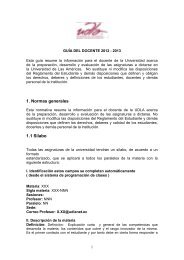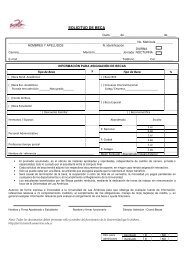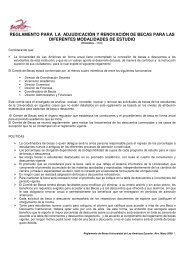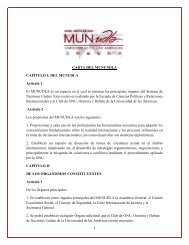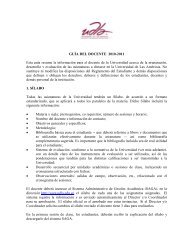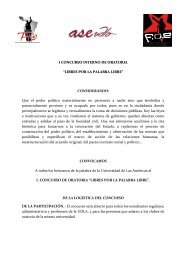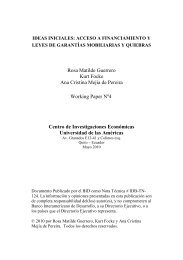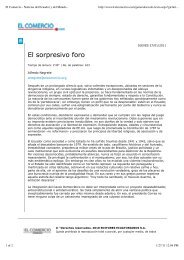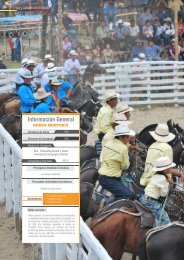Descarga Parte 8 - UDLA
Descarga Parte 8 - UDLA
Descarga Parte 8 - UDLA
You also want an ePaper? Increase the reach of your titles
YUMPU automatically turns print PDFs into web optimized ePapers that Google loves.
341
Fiestas y Sabores del Ecuador<br />
342
DULCES<br />
Cocadas<br />
Espumilla<br />
Helado de Paila<br />
Pristiños<br />
343
Fiestas y Sabores del Ecuador<br />
Cocada<br />
Porciones: 10 • Peso porción: 50 g<br />
U.S. métrico ingredientes<br />
344<br />
1 u<br />
2 tz<br />
1 lb<br />
4 u<br />
2 oz<br />
1 Cda<br />
HACCP<br />
1 u<br />
500 ml<br />
450 g<br />
4 u<br />
60 g<br />
15 g<br />
Coco rallado<br />
Leche<br />
Azúcar<br />
Yema de huevo<br />
Mantequilla<br />
Zumo de limón sutil<br />
PCC1: Recibir y almacenar la leche y la mantequilla a temperatura de refrigeración<br />
(4ºC).<br />
PCC2: Conservar la perparación en refrigeración (4ºC), envasada en un recipiente<br />
adecuado por máximo 48 horas.<br />
Portions: 10 • Portion size: 50 g<br />
U.S. metric ingredients<br />
1 u<br />
2 cup<br />
1 lb<br />
4 u<br />
2 oz<br />
1 Tbsp<br />
HACCP<br />
1 u<br />
500 ml<br />
450 g<br />
4 u<br />
60 g<br />
15 g<br />
Coconut, grated<br />
Milk<br />
Sugar<br />
Egg yolk<br />
Butter<br />
Lemon juice<br />
CCP1: Receive and store milk and butter at refrigeration temperature (39ºF).<br />
CCP2: Store the preparation under refrigeration (39ºF), packaged in an<br />
adequate container for up to 48 hours.<br />
procedimiento<br />
1) Hervir la leche con el azúcar hasta que espese.<br />
2) Añadir el coco rallado y hervir hasta que llegue a punto de bolas suaves.<br />
3) Agregar la mantequilla y sacar del fuego.<br />
4) Mezclar las yemas de huevo con el zumo de limón y agregar en forma de hilo a la anterior<br />
preparación.<br />
5) Llevar nuevamente al fuego hasta que la mezcla se despegue de la base del recipiente.<br />
6) Removerla hasta que se enfríe<br />
7) Porcionarla en esferas de 50 gramos cada una.<br />
Información Nutricional Aproximada:<br />
Calorías Totales: 3568,82 • Calorías por porción: 356,88<br />
Carbohidratos (g)<br />
Proteínas (g)<br />
Lípidos (g)<br />
process<br />
Total<br />
127,22<br />
60,96<br />
312,9<br />
Por porción<br />
12,72<br />
6,09<br />
31,29<br />
Propiedades Nutricionales de la Receta<br />
Un dulce típico esmeraldeño y completamente<br />
recomendado para suministrar energía a deportistas<br />
de resistencia, tras varias horas de actividad física<br />
continua o deportes de altura.<br />
1) Boil milk with sugar until it thickens.<br />
2) Add coconut and boil until soft balls reach a caramelized state.<br />
3) Add butter and remove preparation from the stove.<br />
4) Mix egg yolks and Lemon juice and thinly pour to the previous preparation.<br />
5) Take the preparation to the stove until it peels off the bottom of the pot.<br />
6) Stir until cool.<br />
7) Make 50 gram portions of dough balls.<br />
Nutrition Facts:<br />
Total Calories: 3568,82 • Calories per portion: 356,88<br />
Carbohydrate (g)<br />
Protein (g)<br />
Fat (g)<br />
Total<br />
127,22<br />
60,96<br />
312,9<br />
Per portion<br />
12,72<br />
6,09<br />
31,29<br />
Nutritional Properties<br />
A traditional Esmeraldenian sweet which is<br />
recommended in supplying the athletes body with<br />
energy, after several hours of continues exercise.
Espumilla / Traditional Ecuadorian Meringue<br />
Porciones: 4 • Peso porción: 240 g<br />
U.S. métrico ingredientes<br />
2 u<br />
1 oz<br />
1/2 tz<br />
1/2 cdta<br />
1 Cda<br />
HACCP<br />
2 u<br />
30 g<br />
125 g<br />
3 ml<br />
15 g<br />
Clara de huevo<br />
Azúcar impalpable<br />
Pulpa de fruta<br />
Esencia de vainilla<br />
Zumo de limón sutil<br />
PCC1: Recibir y almacenar la mantequilla a temperatura de refrigeración<br />
(4ºC).<br />
PCC2: Conservar la preparación en refrigeración (4ºC), envasada en un<br />
Portions: 4 • Portion size: 240 g<br />
U.S. metric ingredients<br />
2 u<br />
1 oz<br />
1/2 cup<br />
1/2 tsp<br />
1 Tbsp<br />
recipiente adecuado por máximo 12 horas.<br />
2 u<br />
30 g<br />
125 g<br />
3 ml<br />
15 g<br />
Egg whites<br />
Confectioners sugar<br />
Fruit pulp<br />
Vanilla<br />
Lemon juice<br />
HACCP<br />
CCP1: Receive and store butter at refrigeration temperature (39ºF).<br />
CCP2: Store the preparation under refrigeration (39ºF), packaged in an<br />
adequate container for up to 12 hours.<br />
procedimiento<br />
1) Batir las claras hasta punto de nieve y agregar el azúcar en polvo y la esencia de vainilla.<br />
2) Agregar la pulpa de fruta a las claras batidas en forma envolvente.<br />
3) Servir con grajeas, galleta y sirope de mora o frutilla.<br />
Información Nutricional Aproximada:<br />
Calorías Totales: 92,11 • Calorías por porción: 23,02<br />
Carbohidratos (g)<br />
Proteínas (g)<br />
Lípidos (g)<br />
process<br />
Total<br />
6,47<br />
2,81<br />
6,11<br />
Por porción<br />
1,61<br />
0,7<br />
1,52<br />
1) Whisk egg whites and add the powdered sugar and vanilla.<br />
2) Add fruit pulp to the whisked egg whites in an revolving way.<br />
3) Serve the preparation with sprinkles, cookies and blackberry or strawberry syrup.<br />
Nutrition Facts:<br />
Total Calories: 92,11 • Calories per portion: 23,02<br />
Carbohydrate (g)<br />
Protein (g)<br />
Fat (g)<br />
Total<br />
6,47<br />
2,81<br />
6,11<br />
Per portion<br />
1,61<br />
0,7<br />
1,52<br />
345
Fiestas y Sabores del Ecuador<br />
Helado de Paila / Traditional Ecuadorian Sorbet<br />
Porciones: 4 • Peso porción: 240 g<br />
U.S. métrico ingredientes<br />
346<br />
4 tz<br />
3/4 lb<br />
2 u<br />
c/n<br />
HACCP<br />
1 lt<br />
250 g<br />
2 u<br />
c/n<br />
Pulpa de fruta<br />
Azúcar<br />
Clara de huevo<br />
Hielo seco<br />
PC1: Conservar el helado a temperatura de congelación (-21ºC), envasado<br />
en un recipiente adecuado por máximo 30 días.<br />
Portions: 4 • Portion size: 240 g<br />
U.S. metric ingredients<br />
4 cup<br />
3/4 lb<br />
2 u<br />
a/n<br />
HACCP<br />
1 lt<br />
250 g<br />
2 u<br />
a/n<br />
Fruit pulp<br />
Sugar<br />
Egg whites<br />
Dry ice<br />
CP1: Store the sorbet frozen (-5ºF), packaged in an adequate container for<br />
up to 30 days.<br />
procedimiento<br />
1) Poner la pulpa de fruta y el azúcar en una paila de bronce que debe estar colocada sobre una<br />
cama de paja y hielo seco picado.<br />
2) Girar la paila constantemente y raspar el fondo de la paila con una cuchara de palo para evitar<br />
la cristalización de la azucar hasta que tome consistencia.<br />
3) Batir las claras a punto de nieve e incorporarlas a la pulpa.<br />
4) Seguir girando la preparación en la paila hasta que alcance la consistencia de sorbet.<br />
Información Nutricional Aproximada:<br />
Calorías Totales: 222,76 • Calorías por porción: 55,69<br />
Carbohidratos (g)<br />
Proteínas (g)<br />
Lípidos (g)<br />
process<br />
Total<br />
44,98<br />
6,21<br />
2<br />
Por porción<br />
11,24<br />
15<br />
0,5<br />
Propiedades Nutricionales de la Receta<br />
La forma más nutritiva de consumir un helado es<br />
aprovechando los beneficios naturales de un helado de<br />
paila, que brinda unicamente las calorías de la fruta y la<br />
proteína de la clara de huevo. Un postre ligero y rico en<br />
vitaminas y minerales.<br />
1) Place the pulp and sugar into a bronze pan that lays on a bed of straw and frappe dry ice.<br />
2) Rotate the bronze pan constantly and at the same time scraping off the bottom of the pan with a<br />
wooden large spoon to prevent crystallization of the sugar until it is consistent.<br />
3) Whisk egg whites and add it to the preparation.<br />
4) Continue rotating the preparation in the bronze pan until it reaches a sorbet consistency.<br />
Nutrition Facts:<br />
Total Calories: 222,76 • Calories per portion: 55,69<br />
Carbohydrate (g)<br />
Protein (g)<br />
Fat (g)<br />
Total<br />
44,98<br />
6,21<br />
2<br />
Per portion<br />
11,24<br />
15<br />
0,5<br />
Nutritional Properties<br />
The most nutritious way to eat an ice cream is taking<br />
advantage of the natural benefits of a sorbet which<br />
only provides the calories of fruit and protein from<br />
egg whites. A light dessert rich in vitamin and mineral<br />
content.
Pristiño / Christmas Crowns<br />
Porciones: 6 • Peso porción: 80 g<br />
U.S. métrico ingredientes<br />
Masa<br />
1/2 lb 250 g Harina<br />
1 cdta 5 g Sal<br />
1 cdta 5 g Polvo de hornear<br />
2 oz 60 g Mantequilla<br />
1 cdta 5 g Zumo de limón sutil<br />
5 Cdas 65 ml Agua<br />
c/n c/n Aceite vegetal<br />
Miel de panela<br />
1 lb 450 g Panela<br />
2 tz 500 ml Agua<br />
1 u 1 u Rama de canela<br />
1 cdta 5 g Zumo de limón<br />
HACCP<br />
PCC1: Recibir y almacenar la mantequilla a temperatura de refrigeración<br />
(4ºC).<br />
PCC2: Conservar la masa de la preparación en refrigeración (4ºC),<br />
envasada en un recipiente adecuado por máximo 24 horas o en<br />
congelación (-18ºC) por máximo 30 días.<br />
Portions: 4 • Portion size: 240 g<br />
U.S. metric ingredients<br />
1/2 lb<br />
1 tsp<br />
1 tsp<br />
2 oz<br />
1 tsp<br />
5 Tbsp<br />
a/n<br />
1 lb<br />
2 cup<br />
1 u<br />
1 tsp<br />
HACCP<br />
250 g<br />
5 g<br />
5 g<br />
60 g<br />
5 g<br />
65 ml<br />
a/n<br />
450 g<br />
500 ml<br />
1 u<br />
5 g<br />
Dough<br />
Flour<br />
Salt<br />
Baking powder<br />
Butter<br />
Lemon juice<br />
Water<br />
Vegetable oil<br />
Cane Sugar Syrup<br />
Cane Sugar<br />
Water<br />
Cinnamon<br />
Lemon juice<br />
CCP1: Receive and store butter at refrigeration temperature (39ºF).<br />
CCP2: Store the dough of the preparation under refrigeration (39ºF),<br />
packaged in an adequate container for up to 24 hours or frozen<br />
(0ºF) for up to 30 days.<br />
procedimiento<br />
Masa<br />
1) Cernir la harina, la sal y el polvo de hornear.<br />
2) Mezclar la harina con la mantequilla hasta que la preparación esté arenosa.<br />
3) Agregar poco a poco el zumo de limón y el agua, amasar durante 10 minutos y dejar reposar<br />
por otros 45 minutos.<br />
4) Extender la masa hasta que tenga 3 milímetros de espesor y cortarla en tiras de 2 centímetro<br />
de ancho.<br />
5) Hacer incisiones de medio centímetro por cada lado.<br />
6) Cerrar formando un aro y freír.<br />
Miel de panela<br />
7) Hervir el agua con la panela, la canela y el zumo de limón<br />
hasta que tome consistencia de miel. (100ºC)<br />
Información Nutricional Aproximada:<br />
Calorías Totales: 3453,53 • Calorías por porción: 575,58<br />
Carbohidratos (g)<br />
Proteínas (g)<br />
Lípidos (g)<br />
process<br />
Total<br />
593,11<br />
13,75<br />
11,01<br />
Por porción<br />
98,85<br />
2,29<br />
19<br />
Dough<br />
1) Sieve flour, salt, and baking powder.<br />
2) Mix butter into a flour mixture until a grainy consistency is. achieved.<br />
3) Gradually add the Lemon juice then the water gradually, knead for 10 minutes until the dough is<br />
elastic and let it rest for 45 minutes.<br />
4) Spread the dough 3 millimeters thick. Cut strips of 2 centimeters wide.<br />
5) Cut half-centimeter incisions on each side of strips.<br />
6) Close making a crown and fry..<br />
Cane Sugar Syrup<br />
7) Boil water with cane sugar and Lemon juice until it has a honey consistency.<br />
Nutrition Facts:<br />
Total Calories: 3453,53 • Calories per portion: 575,58<br />
Carbohydrate (g)<br />
Protein (g)<br />
Fat (g)<br />
Total<br />
593,11<br />
13,75<br />
11,01<br />
Per portion<br />
98,85<br />
2,29<br />
19<br />
347
Fiestas y Sabores del Ecuador<br />
348
BEBIDAS<br />
Canelazo<br />
Chicha del Yamor<br />
Colada Morada<br />
Licor de Ovo<br />
Rosero<br />
Tardon Mireño<br />
Vino Hervido<br />
349
Fiestas y Sabores del Ecuador<br />
Canelazo / Hot Cinnamon Cocktail<br />
Porciones: 4 • Peso porción: 240 g<br />
U.S. métrico ingredientes<br />
350<br />
4 u<br />
2 u<br />
2 u<br />
2 tz<br />
1/2 tz<br />
1 1/2 tz<br />
2 oz<br />
4 u<br />
2 u<br />
2 u<br />
500 ml<br />
125 g<br />
360 ml<br />
60 g<br />
Ramas de canela<br />
Clavo de olor<br />
Hoja de naranja<br />
Agua<br />
Panela<br />
Pulpa de naranjilla<br />
Puntas<br />
HACCP<br />
PCC1: Conservar la preparación en refrigeración (4ºC), envasada en un<br />
recipiente adecuado por máximo 24 horas.<br />
NOTA Servir la preparación caliente.<br />
Portions: 4 • Portion size: 240 g<br />
U.S. metric ingredients<br />
4 u<br />
2 u<br />
2 u<br />
2 cup<br />
1/2 cup<br />
1 1/2 cup<br />
2 oz<br />
4 u<br />
2 u<br />
2 u<br />
500 ml<br />
125 g<br />
360 ml<br />
60 g<br />
Cinnamon<br />
Clove<br />
Orange leaves<br />
Water<br />
Cane Sugar<br />
Naranjilla pulp<br />
Puntas (sugar cane liquor)<br />
HACCP<br />
CCP1: Store the preparation under refrigeration (39ºF), packaged in an<br />
adequate container for up to 24 hours.<br />
NOTE Serve hot.<br />
procedimiento<br />
1) Hervir todos los ingredientes y cernir.<br />
2) Agregar el aguardiente al momento de servir.<br />
Información Nutricional Aproximada:<br />
Calorías Totales: 1566,17 • Calorías por porción: 391,54<br />
Carbohidratos (g)<br />
Proteínas (g)<br />
Lípidos (g)<br />
process<br />
Total<br />
386<br />
28<br />
0,97<br />
1) Boil all the ingredients and Drain.<br />
2) Add arguardiente when serving.<br />
Nutrition Facts:<br />
Por porción<br />
96,64<br />
0,7<br />
0,24<br />
Total Calories: 735,8 • Calories per portion: 245,27<br />
Carbohydrate (g)<br />
Protein (g)<br />
Fat (g)<br />
Total<br />
87,7<br />
47,83<br />
21,52<br />
Per portion<br />
29,23<br />
15,94<br />
7,17
Chicha del Yamor / Corn Beverage<br />
Porciones: 20 • Peso porción: 240 g<br />
U.S. métrico ingredientes<br />
1/2 lb<br />
1/2 lb<br />
1/2 lb<br />
1/2 lb<br />
1/2 lb<br />
1/2 lb<br />
1/2 lb<br />
20 tz<br />
2 oz<br />
2 oz<br />
1 u<br />
2 u<br />
200 g<br />
200 g<br />
200 g<br />
200 g<br />
200 g<br />
200 g<br />
200 g<br />
5 lt<br />
50 g<br />
50 g<br />
1 u<br />
2 u<br />
Maíz amarillo<br />
Maíz blanco<br />
Maíz negro<br />
Chulpi<br />
Canguil<br />
Morocho<br />
Jora (maíz germinado)<br />
Agua<br />
Cedrón<br />
Hierba luisa<br />
Cáscara de piña<br />
Naranjilla<br />
Portions: 20 • Portion size: 240 g<br />
U.S. metric ingredients<br />
1/2 lb<br />
1/2 lb<br />
1/2 lb<br />
1/2 lb<br />
1/2 lb<br />
1/2 lb<br />
1/2 lb<br />
20 cup<br />
2 oz<br />
2 oz<br />
1 u<br />
2 u<br />
200 g<br />
200 g<br />
200 g<br />
200 g<br />
200 g<br />
200 g<br />
200 g<br />
5 lt<br />
50 g<br />
50 g<br />
1 u<br />
2 u<br />
Dry yellow corn<br />
White corn<br />
Purple corn<br />
Chulpi (Andean corn)<br />
Popcorn grain<br />
Morocho<br />
Jora (germinated corn)<br />
Water<br />
Lemon verbena<br />
Lemon grass<br />
Pineapple peel<br />
Naranjilla<br />
procedimiento<br />
1) Dejar secar los granos al sol para después molerlos.<br />
2) Cocinar la harina obtenida de la molienda con el cedrón, hierba luisa, cáscara de piña y la<br />
naranjilla de 8 a 10 horas.<br />
3) Cernir la preparación y enfriar.<br />
4) Reservar la bebida en toneles de barro y dejar reposar por<br />
2 días para que alcance el punto de fermentación apto para el consumo.<br />
Información Nutricional Aproximada:<br />
Calorías Totales: 975,93 • Calorías por porción: 48,79<br />
Carbohidratos (g)<br />
Proteínas (g)<br />
Lípidos (g)<br />
HACCP<br />
PCC1: Conservar la preparación en refrigeración (4ºC), envasada en un recipiente adecuado por máximo 48 horas.<br />
process<br />
Total<br />
193,92<br />
25,11<br />
11,09<br />
Por porción<br />
9,69<br />
1,25<br />
0,55<br />
Propiedades Nutricionales de la Receta<br />
Bebida típica ecuatoriana, que brinda energía natural<br />
para las fiestas nacionales. No recomendado en niños<br />
ni mujeres embarazadas.<br />
1) Let the sun dry the grains. Ground grain.<br />
2) Boil the flour obtained from the grounded grains with lemon verbena, lemon grass, pineapple<br />
peel and Naranjilla for about 8 to 10 hours.<br />
3) Drain the preparation and cool.<br />
4) Store the preparation in a clay or wooden container and let it rest for 2 days, letting the preparation<br />
reach a good fermentation grade for consumption.<br />
Nutrition Facts:<br />
Total Calories: 975,93 • Calories per portion: 48,79<br />
Carbohydrate (g)<br />
Protein (g)<br />
Fat (g)<br />
HACCP<br />
CCP1: Store the preparation under refrigeration (39ºF), packaged in an adequate container for up to 48 hours.<br />
Total<br />
193,92<br />
25,11<br />
11,09<br />
Per portion<br />
9,69<br />
1,25<br />
0,55<br />
Nutritional Properties<br />
The Ecuadorian corn beverage, provides natural energy<br />
during national festivities. It is not recommended for<br />
children or pregnant women.<br />
351
Fiestas y Sabores del Ecuador<br />
Colada Morada<br />
Porciones: 20 • Peso porción: 240 g<br />
U.S. métrico ingredientes<br />
352<br />
12 tz<br />
1 lb<br />
1/2 lb<br />
2 tz<br />
4 u<br />
6 u<br />
2 u<br />
1 u<br />
1 u<br />
6 u<br />
6 u<br />
3 u<br />
10 u<br />
2 tz<br />
2 tz<br />
1 1/2 lb<br />
2 tz<br />
1 tz<br />
2 tz<br />
1 1/2 lb<br />
3 lt<br />
450 g<br />
225 g<br />
500 g<br />
4 u<br />
6 u<br />
2 u<br />
1 u<br />
1 u<br />
6 u<br />
6 u<br />
6 u<br />
6 u<br />
500 g<br />
500 ml<br />
675 g<br />
450 g<br />
225 g<br />
450 g<br />
675 g<br />
Base<br />
Agua<br />
Mora<br />
Mortiño<br />
Pulpa de naranjilla<br />
Clavo de olor<br />
Pimienta dulce<br />
Ramas de canela<br />
Ishpingo*<br />
Rama de ataco<br />
Cedrón<br />
Hoja de naranja<br />
Hierba luisa<br />
Hoja de arrayan<br />
Colada<br />
Maicena<br />
Agua<br />
Azúcar<br />
Babaco, cubos pequeños<br />
Durazno, cubos medianos<br />
Piña, cubos medianos<br />
Frutilla en cuartos<br />
Portions: 20 • Portion size: 240 g<br />
U.S. metric ingredients<br />
Base<br />
12 cup<br />
1 lb<br />
1/2 lb<br />
2 cup<br />
4 u<br />
6 u<br />
2 u<br />
1 u<br />
1 u<br />
6 u<br />
6 u<br />
3 u<br />
10 u<br />
3 lt<br />
450 g<br />
225 g<br />
500 g<br />
4 u<br />
6 u<br />
2 u<br />
1 u<br />
1 u<br />
6 u<br />
6 u<br />
6 u<br />
6 u<br />
Water<br />
Blackberry<br />
Andean blueberries<br />
Naranjilla pulp<br />
Clove<br />
Allspice<br />
Cinnamon<br />
Ishpingo*<br />
Branch of amaranth<br />
Lemon verbena<br />
Orange leaves<br />
Lemon grass<br />
Myrtle leaves<br />
Process<br />
2 cup<br />
2 cup<br />
1 1/2 lb<br />
2 cup<br />
1 cup<br />
2 cup<br />
1 1/2 lb<br />
500 g<br />
500 ml<br />
675 g<br />
450 g<br />
225 g<br />
450 g<br />
675 g<br />
Corn starch<br />
Water<br />
Sugar<br />
Babaco, small cubes<br />
Peach, medium cubes<br />
Pineapple, medium cubes<br />
Strawberries, cut into quarters<br />
procedimiento<br />
Base<br />
1 )Hervir todos los ingredientes hasta ebullición durante 20 minutos.<br />
Colada<br />
2) Disolver la maicena en agua fría, agregar el azúcar y añadir a la base.<br />
3) Agregar la fruta.<br />
4) Dejar cocinar hasta que se suavice la fruta.<br />
Información Nutricional Aproximada:<br />
Calorías Totales: 13569,5 • Calorías por porción: 1130,4<br />
Carbohidratos (g)<br />
Proteínas (g)<br />
Lípidos (g)<br />
process<br />
Total<br />
1486,9<br />
31,65<br />
13,95<br />
Por porción<br />
115,18<br />
10,5<br />
4,65<br />
Propiedades Nutricionales de la Receta<br />
La colada morada, reúne una variedad de frutas ricas en<br />
antioxidantes, fibra y vitaminas. Estas propiedades se<br />
fusionan con las características estimulantes de la canela,<br />
ishpingo, pimiento y demás especies, que junto con las<br />
bondades energéticas de la maicena, convierten en una<br />
bebida nutritiva y saludable para todas las edades.<br />
HACCP<br />
PCC1: Conservar la preparación en refrigeración (4ºC), envasada en un recipiente adecuado por máximo 24 horas o en<br />
congelación por máximo 30 días.<br />
* Flor de la canela<br />
Base<br />
1) Boil all the ingredients for 20 minutes.<br />
Process<br />
2) Dissolve the corn starch in cold water with the sugar and add to the base.<br />
3) Add the chopped fruit.<br />
4) Cook until fruits soften.<br />
Nutrition Facts:<br />
Total Calories: 735,8 • Calories per portion: 245,27<br />
Carbohydrate (g)<br />
Protein (g)<br />
Fat (g)<br />
Total<br />
87,7<br />
47,83<br />
21,52<br />
Per portion<br />
29,23<br />
15,94<br />
7,17<br />
Nutritional Properties<br />
Colada Morada puts together a great variety of fruits which are<br />
rich in antioxidants, fiber and vitamins. These properties merge<br />
with the stimulating properties of cinnamon, ishpingo, allspice,<br />
and rest of the herbs that combine with the energetic properties<br />
of corn starch, this drink is a nutritious and healthy beverage<br />
for all ages.<br />
HACCP<br />
CCP1: Store the preparation under refrigeration (39ºF), packaged in an adequate container for up to 24 hours or frozen for<br />
up to 30 days.<br />
* Flower of the cinnamon
Licor de Ovo / Ovo Liquor<br />
Porciones: 5 • Peso porción: 150 g<br />
U.S. métrico ingredientes<br />
1 lb<br />
4 tz<br />
1/2 lb<br />
1 tz<br />
2 oz<br />
2 oz<br />
450 g<br />
300 ml<br />
250 g<br />
250 ml<br />
50 g<br />
50 g<br />
Portions: 5 • Portion size: 150 g<br />
U.S. metric ingredients<br />
1 lb<br />
4 cup<br />
1/2 lb<br />
1 cup<br />
2 oz<br />
2 oz<br />
450 g<br />
300 ml<br />
250 g<br />
250 ml<br />
50 g<br />
50 g<br />
Ovo<br />
Puntas (aguardiente de caña)<br />
Azúcar<br />
Agua<br />
Hierba luisa<br />
Piel de limón<br />
HACCP<br />
PCC1: Conservar la preparación en refrigeración (4ºC), envasada en un<br />
recipiente adecuado por máximo 6 meses.<br />
Ovo<br />
Puntas (sugar cane liquor)<br />
Sugar<br />
Water<br />
Lemon grass<br />
Lemon peel<br />
HACCP<br />
CCP1: Store the preparation under refrigeration (39ºF), packaged in an<br />
adequate container for up to 6 months.<br />
procedimiento<br />
1) Hacer un almíbar con el agua y el azúcar.<br />
2) Aromatizar el almíbar con hierba luisa y piel de limón.<br />
Cernir y enfriar.<br />
3) Prensar los ovos y destilar hasta que obtengamos un líquido semitransparente.<br />
4) Mezclar el almíbar con el líquido destilado y las puntas para ayudar a la fermentación<br />
Información Nutricional Aproximada:<br />
Calorías Totales: 1066,78 • Calorías por porción: 213,35<br />
Carbohidratos (g)<br />
Proteínas (g)<br />
Lípidos (g)<br />
process<br />
Total<br />
256<br />
7,32<br />
1,5<br />
Por porción<br />
51,2<br />
1,46<br />
0,3<br />
1) Make a syrup with water and sugar.<br />
2) Aromatize the syrup with lemon grass and lemon peel.<br />
Drain and cool.<br />
3) Press the ovos and distill its juice until getting a semitransparent liquid.<br />
4) Mix the syrup with the distilled liquid and puntas to aid fermentation.<br />
Nutrition Facts:<br />
Total Calories: 1066,78 • Calories per portion: 213,35<br />
Carbohydrate (g)<br />
Protein (g)<br />
Fat (g)<br />
Total<br />
256<br />
7,32<br />
1,5<br />
Per portion<br />
51,2<br />
1,46<br />
0,3<br />
Propiedades Nutricionales de la Receta<br />
Puede reemplazar el azucar por edulcorante sin calorías<br />
para lograr una bebida ligera.<br />
Nutritional Properties<br />
Sugar can be replace by a sugar free and calorie free<br />
sweetener to make this beverage lighter.<br />
353
Fiestas y Sabores del Ecuador<br />
Rosero<br />
Porciones: 16 • Peso porción: 240 g<br />
U.S. métrico ingredientes<br />
354<br />
1 lb<br />
16 tz<br />
3 lb<br />
1 lb<br />
2 u<br />
1 u<br />
1 tz<br />
1/2 tz<br />
2 oz<br />
2 oz<br />
2 oz<br />
2 oz<br />
2 oz<br />
2 oz<br />
450 g<br />
4 lt<br />
1.3 kg<br />
450 g<br />
2 u<br />
1 u<br />
250 ml<br />
125 ml<br />
50 g<br />
50 g<br />
50 g<br />
50 g<br />
50 g<br />
50 g<br />
Mote<br />
Agua<br />
Azúcar<br />
Frutillas, brunoise<br />
Babaco<br />
Piña<br />
Zumo de limón sutil<br />
Agua de azares<br />
Hierba Luisa<br />
Hoja de naranja<br />
Hoja de arrayan<br />
Canela<br />
Clavo de olor<br />
Pimienta dulce<br />
HACCP<br />
PCC1: Conservar la preparación en refrigeración (4ºC), envasada en un<br />
recipiente adecuado por máximo 24 horas o en congelación (-18ºC) por<br />
máximo 30 días.<br />
Portions: 16 • Portion size: 240 g<br />
U.S. metric ingredients<br />
1 lb<br />
16 cup<br />
3 lb<br />
1 lb<br />
2 u<br />
1 u<br />
1 cup<br />
1/2 cup<br />
2 oz<br />
2 oz<br />
2 oz<br />
2 oz<br />
2 oz<br />
2 oz<br />
450 g<br />
4 lt<br />
1.3 kg<br />
450 g<br />
2 u<br />
1 u<br />
250 ml<br />
125 ml<br />
50 g<br />
50 g<br />
50 g<br />
50 g<br />
50 g<br />
50 g<br />
Hominy<br />
Water<br />
Sugar<br />
Strawberries, brunoise<br />
Babaco<br />
Pineapple<br />
Lemon juice<br />
Orange flowers infusion<br />
Lemon grass<br />
Orange leaves<br />
Myrtle leaves<br />
Cinnamon<br />
Clove<br />
Allspice<br />
HACCP<br />
CCP1: Store the preparation under refrigeration (39ºF), packaged in an<br />
adequate container for up to 24 hours or frozen (0ºF) for up to 30<br />
days.<br />
procedimiento<br />
1) Retirar el germen del mote y cortarlo en láminas finas.<br />
2) Cocinar el mote. Cernir y reservar el agua.<br />
3) Preparar un almíbar con el azúcar, hoja de naranja, hierba luisa, hoja de arrayán, canela, clavo<br />
de olor, pimienta dulce y el agua de cocción del mote.<br />
4) Licuar el almíbar con el babaco y la mitad de la piña.<br />
Cernir y reservar.<br />
5) Cortar la otra mitad de la piña en cubos pequeños.<br />
6) Mezclar las frutillas, la piña cortada, el almíbar con babaco y piña, el zumo de limón, el agua<br />
de azares y el mote.<br />
7) Servir frío.<br />
Información Nutricional Aproximada:<br />
Calorías Totales: 1282,85 • Calorías por porción: 80,17<br />
Carbohidratos (g)<br />
Proteínas (g)<br />
Lípidos (g)<br />
process<br />
1) Remove the germ from the hominy and slice in strips.<br />
2) Boil hominy. Drain the water and set aside.<br />
3) Make a syrup with sugar, orange leaves, lemon grass, myrple leaves, cinnamon, clove, allspice,<br />
and boiled water.<br />
4) Liquefy the syrup with babaco and half of the pineapple.<br />
Drain and set aside.<br />
5) Cut the other half of the pineapple into small cubes.<br />
6) Mix strawberries, cut pineapple, blended syrup, Lemon juice, orange flowers infusion and<br />
hominy.<br />
7) Serve cold.<br />
Nutrition Facts:<br />
Total<br />
284,33<br />
17,28<br />
8,49<br />
Por porción<br />
17,7<br />
1,08<br />
0,53<br />
Total Calories: 1282,85 • Calories per portion: 80,17<br />
Carbohydrate (g)<br />
Protein (g)<br />
Fat (g)<br />
Total<br />
284,33<br />
17,28<br />
8,49<br />
Per portion<br />
17,7<br />
1,08<br />
0,53<br />
Propiedades Nutricionales de la Receta<br />
Una combinación adecuada de frutas, mote y hierbas<br />
estimulantes, brindan la cantidad necesaria de<br />
vitaminas, minerales y energía para tener un óptimo<br />
rendimiento día a día. Consuma acompañando sus<br />
comidas, o como bebida rehidratante.<br />
Nutritional Properties<br />
An adequate mixing of fruits, hominy and stimulant<br />
herbs, provides the necessary amount of vitamins,<br />
minerals, and energy enabling optimal daily<br />
performance. This beverage accompanies meals, or it<br />
can be considered a rehydration beverage.
Tardón Mireño<br />
Porciones: 10 • Peso porción: 200 g<br />
U.S. métrico ingredientes<br />
4 tz<br />
4 tz<br />
1/2 lb<br />
1 tz<br />
2 oz<br />
2 oz<br />
1 lt<br />
1 lt<br />
250 g<br />
250 ml<br />
50 g<br />
50 g<br />
Portions: 10 • Portion size: 200 g<br />
U.S. metric ingredients<br />
4 cup<br />
4 cup<br />
1/2 lb<br />
1 cup<br />
2 oz<br />
2 oz<br />
1 lt<br />
1 lt<br />
250 g<br />
250 ml<br />
50 g<br />
50 g<br />
Zumo de naranja<br />
Puntas (aguardiente de caña)<br />
Azúcar<br />
Agua<br />
Hierba luisa<br />
Hoja de naranja<br />
HACCP<br />
PCC1: Conservar la preparación en refrigeración (4ºC), envasada en un<br />
recipiente adecuado por máximo 6 meses.<br />
Orange juice<br />
Puntas (sugar cane liquor)<br />
Sugar<br />
Water<br />
Lemon grass<br />
Orange leaves<br />
HACCP<br />
CCP1: Store the preparation under refrigeration (39ºF), packaged in an<br />
adequate container for up to 6 months.<br />
procedimiento<br />
1) Hacer un almíbar con el agua y el azúcar.<br />
2) Aromatizar el almíbar con hierba luisa y hoja de naranja.<br />
Cernir y enfriar.<br />
3) Mezclar el almíbar con el zumo de naranja y las puntas.<br />
Información Nutricional Aproximada:<br />
Calorías Totales: 967,49 • Calorías por porción: 96,7<br />
Carbohidratos (g)<br />
Proteínas (g)<br />
Lípidos (g)<br />
process<br />
Total<br />
224,96<br />
12,3<br />
2,05<br />
Por porción<br />
89,8<br />
4,92<br />
1,8<br />
1) Make a syrup with water and sugar.<br />
2) Aromatize the syrup with lemon grass and orange leaves.<br />
Drain and cool<br />
3) Mix the syrup with puntas and orange juice.<br />
Nutrition Facts:<br />
Total Calories: 967,49 • Calories per portion: 96,7<br />
Carbohydrate (g)<br />
Protein (g)<br />
Fat (g)<br />
Total<br />
224,96<br />
12,3<br />
2,05<br />
Per portion<br />
89,8<br />
4,92<br />
1,8<br />
355
Fiestas y Sabores del Ecuador<br />
Vino Hervido / Mulled Wine<br />
Porciones: 5 • Peso porción: 150 g<br />
U.S. métrico ingredientes<br />
356<br />
1 lt<br />
1 oz<br />
1 Cda<br />
1 Cda<br />
2 oz<br />
3 oz<br />
1 lt<br />
30 g<br />
15 g<br />
15 g<br />
60 g<br />
90 g<br />
Vino tinto seco<br />
Canela<br />
Pimienta dulce<br />
Clavo de olor<br />
Naranja, ralladura<br />
Azúcar<br />
HACCP<br />
PCC1: Conservar la preparación en refrigeración (4ºC), envasada en un<br />
recipiente adecuado por máximo 24 horas.<br />
Portions: 5 • Portion size: 150 g<br />
U.S. metric ingredients<br />
1 lt<br />
1 oz<br />
1 Tbsp<br />
1 Tbsp<br />
2 oz<br />
3 oz<br />
1 lt<br />
30 g<br />
15 g<br />
15 g<br />
60 g<br />
90 g<br />
Dry red wine<br />
Cinnamon<br />
Allsipce<br />
Clove<br />
Orange zest, grated<br />
Sugar<br />
HACCP<br />
CCP1: Store the preparation under refrigeration (39ºF), packaged in an<br />
adequate container for up to 24 hours.<br />
procedimiento<br />
1) Poner todos los ingredientes en un recipiente y hervir.<br />
2) Servir caliente.<br />
Información Nutricional Aproximada:<br />
Calorías Totales: 1923,24 • Calorías por porción: 384,64<br />
Carbohidratos (g)<br />
Proteínas (g)<br />
Lípidos (g)<br />
process<br />
Total<br />
223,59<br />
2,35<br />
0,13<br />
Por porción<br />
44,71<br />
0,47<br />
0,02<br />
1) Place all the ingredients in a pot and boil.<br />
2) Serve hot.<br />
Nutrition Facts:<br />
Total Calories: 735,8 • Calories per portion: 245,27<br />
Carbohydrate (g)<br />
Protein (g)<br />
Fat (g)<br />
Total<br />
87,7<br />
47,83<br />
21,52<br />
Per portion<br />
29,23<br />
15,94<br />
7,17
357
Fiestas y Sabores del Ecuador<br />
358
Carlos Gallardo de la Puente<br />
Miguel Burneo Monroy<br />
Festivities and F lavors of<br />
Fiestas y Sabores del<br />
Ecuador<br />
359
Fiestas y Sabores del Ecuador<br />
360<br />
GLOSARIO FIESTAS<br />
DIABLADA DE PÍLLARO<br />
Diablada: Fiesta popular, en la cual se interpretan a<br />
diablos que ahuyentan la religión.<br />
Caucara: Carne que acompaña a las tortillas.<br />
CARNAVALES<br />
Taita Carnaval: Papá Carnaval.<br />
Yahuarlocro: Preparación Yahuar – Sangre, Locro –<br />
potaje.<br />
Humita: Del quechua jumint’a, es un alimento de origen<br />
andino, hecho a base de una pasta de maíz cocido y<br />
levemente condimentado, según la región, envuelto en<br />
las propias hojas del maíz y finalmente cocida a vapor.<br />
Tamal: Del náhuatl tamalli, que significa envuelto;<br />
normalmente cocinado a vapor, puede ser con masa<br />
de maíz, mote, papa, etc.; con o sin relleno, envuelto en<br />
hojas de plátano, bijao o achira.<br />
Claudia: Variedad de ciruela, fruta con hueso.<br />
Guaytambo: Variedad de durazno, fruta con hueso.<br />
Curiquingue: Ave andina rapaz y carroñero del tamaño<br />
de una gallina. Personaje que disfrazado del ave<br />
participa en algunas de las fiestas ecuatorianas,<br />
principalmente en las andinas.<br />
Marimba: Instrumento musical de percusión, empleado<br />
en la música Afro ecuatoriana.<br />
Prioste: Personaje designado para patrocinar un festejo.<br />
PAWKAR RAYMI<br />
Pawkar Raymi: Fiesta del florecimiento, celebrada en<br />
febrero, que marca el inicio de la cosecha de granos<br />
tiernos.<br />
Chakana: Cruz andina.<br />
Tayta Urko: Sinónimo de prioste en la fiesta de Pawkar<br />
Raymi.<br />
Pendonero: Personaje emblemático del Pawkar Raymi<br />
que lleva una bandera roja.<br />
FIESTA DEL OVO<br />
Ovo: Variedad de ciruelo de sabor astringente semidulce<br />
cultivado en Ambuquí.<br />
Bomba del Chota: Ritmo tropical tradicional interpretado<br />
por los habitantes del Valle del Chota.<br />
Sancocho de Cerdo: Sopa compuesta por verde y choclo<br />
con carne de cerdo.<br />
Guandul: Variedad de frijol altamente cultivada en la<br />
zona del Valle del Chota.<br />
FESTIVITIES GLOSSARY<br />
DIABLADA DE PÍLLARO<br />
Caucara: Beef that accompanies potato patties.<br />
Diablada: Popular feast, where people portraydevil<br />
dancersrefraining from religion, a symbol of liberty.<br />
CARNIVALS<br />
Claudia: A variety of plum, stone fruit.<br />
Curiquingue: A character who wears a bird costume and<br />
participates in the Andean Ecuadorian festivities.<br />
Guaytambo: Variety of Andean Peach, stone fruit.<br />
Humita: From Quechua jumint’a, Andean origin, made<br />
with lightly seasonedground fresh corn, wrapped in corn<br />
husks and steamed.<br />
Marimba: Percussion instrument, used in Afro<br />
Ecuadorian music.<br />
Prioste: Person designated to sponsor a festivity.<br />
Taita Carnaval: Father Carnival.<br />
Tamal: From Náhuatl tamalli, that means wrapped;<br />
normally steam cooked, it can be made of corn, hominy,<br />
potato, etc.; with or without filling, wrapped in plantain<br />
leaves or canna leaves.<br />
Yahuarlocro: Potatosoup accompanied with dried lamb<br />
blood.<br />
PAWKAR RAYMI<br />
Chakana: Andean cross.<br />
Coya Raymi: Festivity celebrated on September in honor<br />
of the Moon and Earth, a symbol of fertility.<br />
Kapak Raymi: Festivity celebrated on December, in<br />
honor of puberty where boys obtain their first haircuts.<br />
Pawkar Raymi: Festivity of the flowering, celebrated on<br />
February,marks the beginning of the harvest of fresh<br />
grains.<br />
Pendonero: Emblematic character of the Pawkar<br />
Raymiwho holds a red flag in his hands.<br />
Taita Urko: Synonym of “prioste” at the Pawkar Raymi.<br />
FESTIVITIES OF THE OVO<br />
Bomba Del Chota: Traditional tropical rhythm played by<br />
the inhabitants of Valle del Chota.<br />
Guandul: Variety of bean highly cultivated at the Valle del<br />
Chota area.<br />
Ovo: Variety of plum of astringent and semi-sweet taste,<br />
cultivated at Ambuqui.<br />
Sancocho de Cerdo: Soup prepared with plantain, fresh<br />
corn and pork.
FIESTA DEL EQUINOCCIO<br />
Cosmovisión Andina: Concepto o interpretación que las<br />
culturas ancestrales andinas tienen acerca del mundo<br />
que las rodea.<br />
Solsticio: Efecto astral en el cual el sol se ubica sobre<br />
una zona específica de la tierra cambiando el curso de<br />
los días.<br />
Shaman: Sacerdote inca que se supone tiene poderes<br />
curativos.<br />
SEMANA SANTA<br />
Peje: Pez.<br />
Convite: Invitación.<br />
Cucurucho: Personaje que viste un atuendo purpura,<br />
emblemático de la Semana Santa<br />
Verónicas: Mujeres que recuerdan a aquella que se<br />
acercó a Jesús mientras iba al Calvario y le limpió<br />
el rostro cubierto de sudor y sudor. Llevan puestos<br />
vestidos y pañuelos de color purpura.<br />
FIESTA DE LA CHONTA<br />
Chonta: Variedad de palma que se encuentra en el<br />
oriente ecuatoriano y de la cual se obtiene el fruto<br />
conocido como chontaduro.<br />
Chicha: Bebida tradicional ecuatoriana obtenida a través<br />
del fermento de diferentes productos andinos.<br />
Shuar: Grupo étnico situado en la Amazonia de Ecuador<br />
y Perú.<br />
Efemérides: Conmemoración notable en memoria de un<br />
aniversario.<br />
DANZANTES DE PUJILÍ<br />
Shigra: Artesanía de fibra de cabuya, tejida por mujeres<br />
en las provincias centrales andinas para transportar<br />
objetos y/o diferentes productos. Especie de bolsa.<br />
Chingana: Estructura de madera similar a una casa.<br />
Mishqui: Preparación de arroz que contiene cabuya.<br />
Pingullo: Instrumento andino de viento.<br />
Corpus Cristi: Palabra de origen latín que se refiere al<br />
Cuerpo de Cristo.<br />
INTI RAYMI y SAN JUAN<br />
Obraje: En la América colonial, lugar en donde los<br />
españoles imponían a los indios la manufactura de<br />
tejidos y artesanías.<br />
Sanjuanes: Danzantes tradicionales de las fiestas de<br />
San Juan.<br />
SAN PEDRO y SAN PABLO<br />
Patacón: Láminas gruesas, fritas y aplastadas de<br />
plátano verde.<br />
EQUINOCCIAL FESTIVITIES<br />
Andean Cosmo vision: Concept or interpretation that<br />
ancestral Andean cultures hadabout the world that<br />
surrounds them.<br />
Shaman: Inca priest that is supposed to have healing<br />
powers.<br />
Solstice: Astral effect in which the sunlight is located on<br />
a specific area of the earth changing the course of the<br />
day.<br />
SEMANA SANTA<br />
Cucurucho: Emblematic character of Semana Santa that<br />
wears a purple costume.<br />
Peje: Pieces of Bacalao/ Cod fish.<br />
Verónicas: Women who remember the woman who<br />
came to Jesus on his way to Calvary and cleaned<br />
his sweaty face. They wear purple dresses and<br />
handkerchiefs.<br />
FESTIVITIES OF THE CHONTA<br />
Chicha: Traditional Ecuadorian beverage obtained<br />
through the fermentation of different Andean products.<br />
Chonta: Variety of palm that is found in the Ecuadorian<br />
Amazon and providing the fruit called “chontaduro”.<br />
Shuar: Ethnic group located in the Amazon of Ecuador<br />
and Peru.<br />
PUJILÍ DANCERS<br />
Chingana: Wooden structure emulating a house.<br />
Corpus Cristi: Refers to the Body of Christ, Latin origin.<br />
Mishqui: Dish that contains rice and sisal.<br />
Pingullo:Andean wind instrument.<br />
Shigra: Hand-woven artisanal bag madewith fibers by<br />
women from central Andean provinces of Ecuador made<br />
to carry objects or different products.<br />
INTI RAYMI AND SAN JUAN<br />
Inti Raymi: Festivity of the Sun represents the end of the<br />
year, with the harvest of mature grains, marking the New<br />
Year.<br />
Huayna Cápac: Inca leader, father of Atahualpa and<br />
founder of the Inti Raymi Festivity.<br />
Pacha Mama: Mother Earth, Quechua language.<br />
Sanjuanes: Traditional dancers from the festivities of San<br />
Juan.<br />
Serrania: Ecuadorian Highlands.<br />
SAN PEDRO AND SAN PABLO<br />
Patacón: Thick slices of mashed and fried plantain.<br />
Salprieta: Manabí’s preparation consists of<br />
groundtoasted corn and peanut, annatto seeds, parsley,<br />
cumin and salt.<br />
361
Fiestas y Sabores del Ecuador<br />
Salprieta: Preparación manabita que consiste en la<br />
molienda de maíz y maní tostados, semillas de achiote,<br />
perejil, comino y sal.<br />
362<br />
FIESTA CAYAMBE<br />
Bocinero: Personaje que toca las bocinas.<br />
Chinuca: Mujer cantante y danzante de las fiestas<br />
sampedrinas.<br />
Cencerro: Campana tradicional componente de la<br />
vestimenta de ciertos personajes de las fiestas.<br />
Zamarro: Cinturón de cuero utilizado para colgar<br />
campanas.<br />
Quena: Instrumento andino de viento de bisel.<br />
Zampoña: Instrumento andino semejante a un rondador,<br />
compuesto de tubos huecos que al soplarlos producen<br />
diferentes notas musicales.<br />
Cucayo: Provisiones de alimento que se lleva en un viaje.<br />
PASEO DEL CHAGRA<br />
Arretranca: Mecanismo para moderar o detener el<br />
movimiento en las máquinas o carruajes.<br />
Bozadillo: Adorno que se pone a los caballos en el bozo.<br />
Cincha: Banda de cuero que se sujeta a la silla por<br />
debajo del vientre de la caballería.<br />
Grupera: Almohadilla que se pone en las sillas de<br />
montar.<br />
Martingala: Calza que llevan los hombres de armas.<br />
Pellones: Palleja curtida que forma parte de la montura.<br />
Huasca: Ramal que sirve de rienda o látigo.<br />
Criadilla: Nombre gastronómico que reciben los<br />
testículos de cualquier animal de matadero.<br />
FIESTA ESMERALDAS<br />
Cununo: Instrumento musical, tambor cónico.<br />
Guasá: Instrumento de percusión similar a la marimba.<br />
Cimarrón: En la época de la colonia, negro rebelde y<br />
fugitivo.<br />
FIESTA MIRA<br />
Chamiza: Fogata hecha con ramas secas.<br />
Achupalla: Planta abundante sobre las cimas de los<br />
Andes equinocciales.<br />
Cabestro: Ronzal o cuerda que se ata a la cabeza o al<br />
cuello de la caballería.<br />
VIRGEN DEL CISNE<br />
Paltas: Grupo étnico que estaba asentado en la actual<br />
provincia de Loja.<br />
FESTIVITIES OF CAYAMBE<br />
Bocinero: Character who plays the horns.<br />
Cencerro: Traditional bell component of certain<br />
characters of the festivities.<br />
Chinuca: Female singer and dancer from the<br />
“sampedrinas” festivities.<br />
Cucayo: Supplies of food to take on a journey.<br />
Quena: Andean wind instrument.<br />
Zamarro: Leather belt used to hang bells.<br />
Zampoña: Andean wind instrument.<br />
PASSAGE OF THE CHAGRA- MACHACHI<br />
Arretranca: Mechanism to moderate or stop the<br />
movement of machines or carriages.<br />
Bozadillo: Adornment placed on the headstall of horses.<br />
Chacarero: Small farmers, authentic chagras.<br />
Chagra: Andean cowboy of the Sierra.<br />
Cincha/ Cinch: Leather belt that attaches to the chair<br />
under the belly of the horse.<br />
Criadilla: Culinary name of testicles of any animal.<br />
Grupera: Pad that is placed on thesaddles.<br />
Huasca: Branch used as a reins or whip.<br />
Martingala: Gun holster carried by Chagras.<br />
Pellones: Sheepskin saddle blanket.<br />
FESTIVITIES OF ESMERALDAS<br />
Cimarrón: In colonial times, black person rebel and<br />
fugitive.<br />
Cununo: Musical instrument, conical drum, accompanies<br />
the marimba.<br />
Guasá: Percussion instrument similar to the “marimba”.<br />
Panela: A solid piece of unrefined whole cane sugar.<br />
FESTIVITIES OF MIRA<br />
Achupalla: Plant that grows on the tops of the<br />
Ecuadorian Andes.<br />
Cabestro: Halter or rope that is attached to the head or<br />
neck of the horses.<br />
Cabuya: Pita fiber.<br />
Chamiza: Campfire made with dry twigs.<br />
Penca: Nopal stalk.<br />
VIRGEN DEL CISNE<br />
Caña: Variety of cane which sugar is obtained.<br />
Champús: Corn beverage.
Champús: Bebida a base de maíz.<br />
Romería: Caminata de peregrinos que culmina en la<br />
congregación en un santuario.<br />
Wikis: Personajes típico de las fiestas de los Saraguros.<br />
Caña: Variedad de caña de la cual obtenemos el azúcar<br />
y que de la fermentación de su jugo conseguiremos una<br />
clase de aguardiente.<br />
FIESTA DEL YAMOR<br />
Jora: Maíz germinado.<br />
Chulpi: Variedad o especie de maíz andino.<br />
Tonel: Barril de madera.<br />
Pondo de barro: Vasija utilizada por los Incas en la<br />
elaboración de chicha.<br />
FIESTA DE LA JORA<br />
Mojicón: Dulce a base de panela.<br />
Rosqueta: Pequeña rosquilla empolvada con azúcar<br />
impalpable.<br />
FERIA DEL BANANO<br />
Chucula: Bebida a base de plátano.<br />
Bolones: Esferas de plátano verde rellenas con queso y<br />
fritas.<br />
FIESTAS DE IBARRA<br />
Avatar: Fase, cambio vicisitud.<br />
Colaciones: Dulces típicos hechos a base de panela y<br />
leche.<br />
Albazo: Tipo de música de la sierra ecuatoriana de<br />
origen indígena y mestizo.<br />
FIESTA DEL MAIZ Y TURISMO<br />
Haba: Leguminosa de la familia de las fabáceas.<br />
Chacarera: Perteneciente a una chacra o tierra.<br />
Condumio: Condimento o relleno.<br />
FIESTAS DE GUAYAQUIL<br />
Huancavilca: Se dice del individuo de un pueblo<br />
amerindio que habitaba en el margen occidental del río<br />
Guayas.<br />
Benemérito: Digno de galardón.<br />
Chuzo: Carne asada con acompañantes dispuestos en<br />
un palillo.<br />
Guatita: Platillo típico de la gastronomía ecuatoriana que<br />
consiste en estómago de res estofado acompañado con<br />
una porción de arroz y aguacate.<br />
Paltas: Ethnic group that was located in the actual<br />
province of Loja.<br />
Romería: Pilgrimage that culminates at the congregation<br />
of a sanctuary.<br />
Wikis: Typical character from the festivities of<br />
“Saraguros”.<br />
FESTIVITIES OF YAMOR<br />
Jora: Germinated corn.<br />
Chicha of Yamor: Traditional beverage, elaborated with<br />
seven different Andean corn grains, and fermented in a<br />
type of clay barrel celebrated in the Festivities of Yamor.<br />
Chulpi: Variety of Andean corn.<br />
Festivities of Jora<br />
Mojicón: Brown sugar confectionery.<br />
Rosqueta: Small donut dusted with confectioner’s sugar.<br />
MACHALA<br />
Bolones: Spheres of fried plantain stuffed with cheese.<br />
Chucula: Banana based beverage.<br />
FESTIVITIES OF IBARRA<br />
Albazo: Type of music of the highlands of Ecuador’s<br />
indigenous and mestizo origin.<br />
Avatar: Phasechange; vicissitude.<br />
Colaciones: Traditonal sweets prepared with sugar cane<br />
and milk.<br />
FESTIVITIES OF CORN AND TOURISM<br />
Chacarera: Belonging to a farm or land.<br />
Condumio: Fillingor stuffing.<br />
Haba: Broad bean.<br />
FESTIVITIES OF GUAYAQUIL<br />
Benemérito: Dignified of a prize.<br />
Caldo de Bolas: Traditional dish from the city of<br />
Guayaquil consists of green plantain balls in a beef<br />
broth.<br />
Caldo de Manguera: Traditional soup from Guayaquil that<br />
has as main ingredient pork sausage filled with viscera<br />
and blood.<br />
Chuzo: Roasted meat with accompanied pieces of<br />
vegetables on a stick.<br />
Huancavilca: An individual from an American Indian<br />
origin who resides in the western margin of the Guayas<br />
River.<br />
Guatita: Traditional dish of the Ecuadorian cuisine that<br />
consists of beef tripe stew, accompanied with a portion<br />
of rice and avocado.<br />
363
Fiestas y Sabores del Ecuador<br />
Caldo de bolas: Plato tradicional de la ciudad de<br />
Guayaquil que consta de bolas de verde en un caldo de<br />
res.<br />
364<br />
Caldo de Manguera: Sopa típica de Guayaquil que tiene<br />
como ingrediente principal chorizo de cerdo relleno de<br />
viseras y sangre.<br />
RODEO MONTUBIO<br />
Espuela: Espiga de metal terminada comúnmente en<br />
una rodaja o en una estrella con puntas, sujetas al pie<br />
para picar a la cabalgadura.<br />
Corcel: Caballo.<br />
Caracoleo: Doma de un caballo salvaje en la cual el<br />
caballo imita la forma de un caracol para quitar al jinete<br />
de su lomo.<br />
INGA PALLA<br />
Cacique: Persona que ejerce el poder en un grupo<br />
indígena.<br />
Hueste: Ejercito o tropa armada en campaña.<br />
Panzaleo: Grupo étnico que habitaba las tierras donde<br />
ahora se encuentra la provincia de Tungurahua.<br />
Turrón: Dulce obtenido por la cocción de miel a la que<br />
se añade frutos secos.<br />
Inga: Del quechua Inca.<br />
FINADOS<br />
Milpa: Agro ecosistema mesoamericano cuyos<br />
principales componentes productivos son el maíz, frijol<br />
y calabazas.<br />
Misa Campal: Misa que es impartidas al aire libre.<br />
Guagua de pan: Pan de dulce con la forma de una<br />
muñeca.<br />
FIESTAS DE CUENCA<br />
Morlaco: Gentilicio utilizado para definir a la gente de<br />
Cuenca.<br />
Unción: Cobertura espiritual.<br />
Llapingacho: Tortilla de papa rellena de queso.<br />
MAMA NEGRA<br />
Vivandera: Mujer que vende víveres.<br />
Foete: Látigo.<br />
VIRGEN DEL QUINCHE<br />
Cetro: Vara de oro u otra materia preciosa.<br />
Peregrinante: Dícese de la persona que va en procesión.<br />
RODEO MONTUBIO<br />
Caracoleo: Dominating a wild horse in which the horse<br />
imitates the form of a snail as a way to remove the rider<br />
from its back.<br />
Corcel: Horse or steed.<br />
Espuela: Spurs.<br />
INGA PALLA<br />
Cacique: Indigenous leader.<br />
Hueste: Army, group, or troops in action.<br />
Inga: Inca, Quechua Language.<br />
Panzaleo: Ethnic group that resides in lands of the<br />
Tungurahua Province.<br />
Turron: Sweet obtained by the heating of honey with the<br />
addition of dry fruits.<br />
FINADOS<br />
Guagua de Pan: Sweet bread with a shape of a doll.<br />
Milpa: Mesoamerican Agricultural ecosystem, main<br />
productive components are the corn, common beans,<br />
and pumpkin.<br />
FESTIVITIES OF CUENCA<br />
Llapingacho: Potato patty filled with cheese.<br />
Morlaco: A denomination used to define the people of<br />
Cuenca.<br />
LA VIRGEN DEL QUINCHE<br />
Oyacachis: Indigenous Quechua community.<br />
CHRISTMAS<br />
Ashanguero: Character from the Province of Cotopaxi in<br />
charge of carrying the jochas.<br />
Buñuelos: Fried spheres of wheat or corn dough and<br />
confectioner’s sugar.<br />
Chigüalos: Activities of entertainment that are made at<br />
homes in the Ecuadorian coast, during the Christmas<br />
season.<br />
Pristiños: Traditional Quiteñandessert consists of fried<br />
dough strips served with panela honey.<br />
Sahumeriante: Character in charge of carrying the<br />
incense.<br />
Sahumerio: Incenses that release aromatic smoke while<br />
burned.<br />
Yumbada: Festivity of the Yumbos, ancestral pueblo of<br />
Ecuador.<br />
AÑO VIEJO<br />
Año Viejo: Sceneries created in the streets composed of<br />
dolls and legends written on posters.
NAVIDAD<br />
Guirnalda: Corona o tira de flores, hierbas, ramos y otros<br />
materiales entretejidos.<br />
Chigüalos: Actividades de entretenimiento que se<br />
realizan en los hogares de la costa ecuatoriana en<br />
época de navidad.<br />
Pristiños: Postre típico quiteño que consiste en tiras de<br />
masa fritas servidas con miel de panela.<br />
Buñuelos: Esferas de masa de harina de trigo y maíz<br />
fritas y espolvoreadas con azúcar.<br />
Ponche: Bebida a base huevo, crema de leche y licor.<br />
Villancico: Canción navideña.<br />
Vacas locas: Juego tradicional en el que una persona<br />
carga una estructura de juegos pirotécnicos similar a<br />
una vaca mientras esta está prendida.<br />
Pesebre: Belén, representación minimalista del<br />
nacimiento de Cristo.<br />
Yumbada: Fiesta de los Yumbos, pueblo ancestral del<br />
Ecuador.<br />
Ashanguero: Personaje de la provincia de Cotopaxi<br />
encargado de cargar las jochas.<br />
Hollín: Polvo craso y negro que el humo deposita en la<br />
superficie de cuerpos.<br />
Sahumerio: Inciensos que desprenden humo aromático<br />
al ser quemados.<br />
Sahumeriante: Persona encargada de llevar consigo la<br />
olleta con carbón prendido para quemar el sahumerio.<br />
AÑO VIEJO<br />
Monigote: Muñecos confeccionados de ropa vieja,<br />
rellenos de tela o papel periódico; también pueden ser<br />
elaborados de cartón.<br />
Año Viejo: Escenarios creados en las calles que constan<br />
de monigotes y leyendas escritas en pancartas.<br />
GLOSARIO RECETAS<br />
HACCP: Análisis de Peligros y Puntos Críticos de<br />
Control.<br />
PC: Punto de Control.<br />
PCC: Punto de Control Crítico.<br />
Brunoise: Corte de vegetales de 3mm3.<br />
Juliana: Corte de vegetales de 3mm de ancho y alto y<br />
6cm de largo.<br />
Concasse: Proceso en el que se blanquea al tomate, se<br />
lo pela y se corta en cubos sin semillas.<br />
Mirepoix: Corte grueso e irregular de vegetales<br />
RECIPES GLOSARY<br />
HACCP: Hazards Analysis and Critical Control Points.<br />
CP: Control Point.<br />
CCP: Critical Control Point.<br />
Brunoise: Vegetable cut of 3mm3.<br />
Julienne: Vegetable cut of 3mm of wide and height and<br />
6cm of long.<br />
Concasse: Process in which the tomato is blanched,<br />
then it is peeled and cut into cubes without the seeds<br />
Mirepoix: Thick and irregular vegetable cut<br />
365
Fiestas y Sabores del Ecuador<br />
366
Análisis de Bibliografía<br />
Cuvi, Pablo ¡Viva la Fiesta! Ecuador, Primera edición,<br />
Dinediciones, Quito, 2002<br />
Pazos, Julio El Sabor de la memoria historia de la<br />
cocina quiteña, Primera edición, Biblioteca Básica de<br />
Quito, Quito, 2008<br />
Draz John / Koetke Christopher The Culinary<br />
Professional, The Goodheart-Willcox Company,<br />
Tinley Park Illinois US, 2010<br />
Cárdena, Ana Maria Enciclopedia Fechas Cívicas<br />
y Festividades del Ecuador, Cultural S.A, Madrid<br />
España, 2007<br />
Armendaris, Mauricio Mishki Mikuna El Sabor del<br />
Ecuador, Cocina Ecuador, Quito, 2009<br />
367




